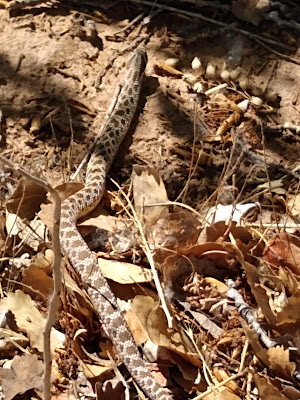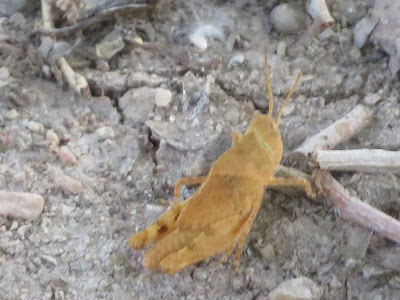It's all in the nose; the funny thing about Summer is there is a lot more smells around. Most of them not to pretty. the birding is much poorer for a while, but in my opinion, more than made up for by the spectacular reptiles and amphibians that abound in the heat, and occasionally; moisture.
This is snake season. Just about all of them are non-venomous, if not exactly friendly. The more I spend in the company of snakes, the more I realize they are the gentle ones of the reptile world. There are a few simple rules of course, slowly approach them from behind and they will (rarely) turn to strike. Keep your hands at your sides and move slowly (like a snake would) this will give you more time to observe them. Then you will also spend less time screeching and acting like a baby bird at feeding time because you saw a scary snake. Most snakes let you get pretty close if they can read your intentions and have other things on their minds.
You will be rewarded with seeing beautiful patterns that rival the best of the flower world. This small snake is a hognose, it has a small, upturned snout it uses to dig with. It is a frog eater and not a threat to anything bigger than your thumb. If you pick it up, it poops on you in self defense
If you pick up a common slider, like this one, you are likely to get pee'd on. This one was sunbathing. Apart from getting a daily dose of heat and Vitamin D, this behavior reduces the parasites on the outside of it's body. This one has a leech attached to it's shell that is slowly being desiccated in the sunshine.
This is a VERY large carpenter ant. It is as big as a wasp, but built very differently. The whole head is heart shaped with sensitive antennae
Compared to a wasp, the eyes are very small. The mandibles are also very solid looking, which makes sense for an insect that works with wood.
I think this hairy wasp is a western yellowjacket. They have painful stings, but not "lethal", this one was sluggish and not at all aggressive. Those "hairs" are used for sensation, and also collecting dust, like pollen. The hairs work by sensing and manipulating electrostatic electricity, the same force that sticks clothes together in the dryer. Notice the hairs form collars along every joint in it's armor, and also on the ends of the legs.
The harvester ants are busy right now collecting and hiding the huge drifts of cottonwood seeds. Those seeds detach from the fluff in wet areas, making them easier to store. I don't doubt that they will likely germinate if stored in tunnels that later become moist, especially in areas of heavy clay.The variety of grasshoppers is looking impressive. the prettiest ones are still tiny though. The largest have already got wings and are mobile over vast areas. Locust swarms are hard to predict, but we should have them in the plains on the east side of New Mexico and in some years form huge clouds, looking for food in farm fields.
As predators go, this tiny mantis is not too scary, but they still freak out a lot of people once they are bigger.
This wasp is jet black, with a hint of blue. I think it is a mud dauber, but it is hard to be sure, there are so many types of wasp out there! If the wings were red, and a bit bigger, then it would most likely be a tarantula wasp; the New Mexico state insect.
The ditches are perfect for the growth of tadpoles like these woodhouse toads. Unfortunately many die as their pools dry out. This means the ditches are visited by predators and scavengers often during the summer. Apart from water, there are many other small critters trapped in pools for those predators who are not afraid of a little mud.
This picture tells of an odd story. The crayfish were collected and pulled out of cracks in the rocks. The footprints appear to be those of a bobcat. Very rounded, whatever it was, and it had an impressive leap.
Oddly, the crayfish do not appear to have been eaten, just fished out of the mud and left alone. They are edible.This is a current. the bush was at the peak of ripeness. I would never advocate foraging fruits you were not 110% certain of, some are posionous. But I did eat this one and it was delicious.
The long fingers and long hind foot show where a raccoon climbed the ditch banks while foraging the riches of the ditch during the night.A little less clear are these smaller squirrel tracks, showing the long claws and deeps pads as the rodent hopped through the mud. We have tree and ground squirrels around, as well as many other critters up in the desert areas, like kangaroo rats, chipmunks, and some many others scampering around the rocks and sand.
















No comments:
Post a Comment